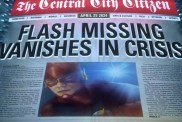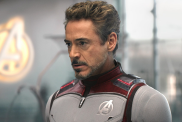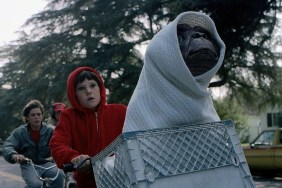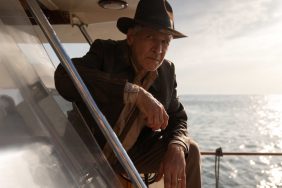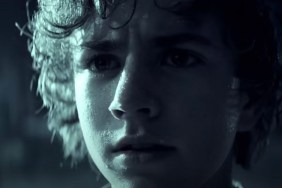With roughly three months to go before its international release, the film has entered its final stages, active scoring is going on in Los Angeles and final sound mixing beginning in Wellington, New Zealand, and completely rendered animation is being finalized every day. Spielberg and Jackson invited ComingSoon.net down to Jackson’s state-of-the-art post-production facility in Wellington to view completed portions of the film as it comes together.
Park Road Post, Jackson’s purpose-built facility nestled in the upscale Wellington suburb of Miramar, is exactly what you’d expect a filmmaker’s home away from home would be like. A cozy, arts and crafts style interior surrounds three mixing stages, a foley room, several editing and mastering suites, and the main theater. Designed by the artisans at nearby Weta Workshop, the main theater is classy and opulent in the way no commercial theater would bother with. Designed to replicate the feel of being outdoors in a Spanish or Italian plaza, the walls are lined with faux-tiled roofs, statues and columns, and the ceiling is a deep blue, studded with twinkling lights as if it were the night sky.
Seated at the front of the theater, facing the very comfortable seats lined up stadium style within, is Jackson himself, looking as scruffy and un-kept as he did while making the “Lord of the Rings” films, with only a hint more grey in his hair to mark the passage of time. Next to him is a large LCD television with several cameras around it allowing the audience to see, and be seen by, Spielberg and his producer Kathleen Kennedy, who are seated in a similar theater several thousands of miles away in LA.
This early morning screening is actually the reverse of much of “Tintin’s” production life, Jackson described, as he often had to wake up at four in the morning during capture to join the production as it took place in half a world away. The time difference (Spielberg himself has never traveled to Wellington) is but one of the unique features that make “Tintin” so different from any Spielberg film before.
The collaboration actually began six years earlier, in 2005, when Spielberg asked Weta Digital for a feasibility test for putting a computer generated Snowy (Tintin’s faithful dog companion) into a live-action “Tintin” production. Jackson, still in the midst of production on King Kong at the time and with a full crew at his disposal, took it upon himself to shoot the test on the set of the ‘Venture’ with himself in the starring role of Captain Haddock (Tintin’s faithful non-dog companion).
The lights in the theater dimmed for the first of the three clips shown that morning, Jackson’s original test. It consists of Jackson, in full Haddock costume, walking along a dock and explaining how he was perfect for the role and had dreamed of playing him ever since “growing a beard at seven years old.” He tries his best throughout to ignore the CGI dog jumping around his heels before accidentally knocking it in the ocean and diving after it. The sum total of the test was to convince Spielberg “not to do Tintin in live-action” the director said. It did, however, convince him that “I had a partner in crime in ‘Tintin.'”
That partnership, which Spielberg describes as “doing a crossword puzzle with a friend,” would lead to a film which, when it is released this fall, will have been in one stage of production or another for six-and-a-half years.

Once that work is done, Spielberg and his actors–Jamie Bell, Andy Serkis, Daniel Craig, Simon Pegg, Nick Frost, Gad Elmaleh, Toby Jones and Mackenzie Crook–congregated on a soundstage in Los Angeles to begin capturing The Adventures of Tintin.
“It’s like shooting a super 8 film,” Jackson explained. “This was a lot like that, except instead of a camera you’re running around with a PlayStation controller,” Spielberg agreed. “You become the focus puller, the dolly grip – I actually lit it with some help from Weta. I did a lot of jobs I don’t normally do.”
Despite that new way of working, or perhaps because of it, “Tintin” is immediately recognizable as a Spielberg film. The director chose to shoot in a conventional style, staying largely away from the extended, whipsawing camera moves of many motion captured CGI films; instead using cuts to move his action along and physics to determine camera placement as much as possible. He also shot his actors in the same way he would a live-action film, moving the camera for each close-up and getting new performances for each set up, Jackson explained.
“He’d do 6 or 7 takes with Jamie and then set up for a new shot with Andy and do 6 or 7 takes with him,” Jackson said. This was quite a departure from the way James Cameron shot Avatar where he would capture the entire master shot of a scene and then pick his camera angles after the fact, sometimes years afterwards. Spielberg instead picked his angles as he went, essentially building his edit during the capture process, though he has reveled somewhat in the ability to ‘shoot’ pick up material whenever wants.
“I could pick new shots now, or even a month from now, and we’d still be able to get them in in time for release,” he said.
Still, the largely ‘conventional approach’ he picked is obvious as soon as the second clip begins playing. This part is brand new with several sections in various stages of rendering. It also boasts the first released section from John Williams score, just two days old at this point, which has been quickly mixed in to the dialogue and sound effects in order to make as complete an experience as possible.
It begins with Tintin being chloroformed at his front door and driven off, prompting Snowy to leap from a nearby window onto a passing fire truck, then from car to car and eventually cow to cow as he races to keep up with the abductors. It’s replete with the kind of light visual gags and tight editing we’re used to from ‘fun’ Spielberg films and the score matches the look in kind, a kind of light, jingly mashing of “E.T.” and “Indiana Jones.” Which, in many ways, sums up the tone of “Tintin,” which though photo-real can quickly flip to being pure cartoon.

“It’s a mixture of action-adventure, slapstick, satire, it’s a strange mix,” Spielberg said, and sticking to that tone was something they tried to do throughout the script-writing process, which Spielberg maintained was the most important part of putting “Tintin” together and took almost as long as designing the film. “We always return to story, plot, characters,” he said.
For that they turned to “Doctor Who” writer Steven Moffat on Jackson’s (an admitted “Who” fan) recommendation, due to the similarities in mixed tone which would have to be brought out. And when Moffat had to return to the show after turning in several drafts Jackson brought in Edgar Wright and Joe Cornish to finish working on the screenplay because “we wanted to have a European sensibility, we wanted to have writers who were ‘Tintin’ fans,” Spielberg said.
Like many film adaptations, Spielberg and Jackson have strived to be true to the spirit of the source material but not necessarily to the letter, combining pieces of several different “Tintin” adventures together in order to make the first of what they hope will be several installments.
“We wanted Haddock and Tintin to meet for the first time, but that book [‘The Crab with the Golden Claws’] wasn’t the best,” for a straight adaptation, Jackson explained. “But ‘Secret of the Unicorn’ goes into Haddock’s ancestry, where he comes from, making it a natural fit.”
So Spielberg, Jackson and the various screenwriters combined bits and pieces of the two books–among other things increasing the villainy of the film’s nemesis Ivan Ivanovitch Sakharine (the character Daniel Craig plays, as opposed to the previously reported pirate Red Rackham)–together with some elements from ‘Unicorn’s’ sequel “Red Rackham’s Treasure” to create the film’s eventual story though much of “Red Rackham” was set aside for Tintin 2.
“The second film would go into [‘Red Rackham’s Treasure’],” Jackson said, which he himself planned to direct. “That’s the idea.”
The Adventures of Tintin opens in 3D, 2D and IMAX 3D theaters in North America on December 23.
